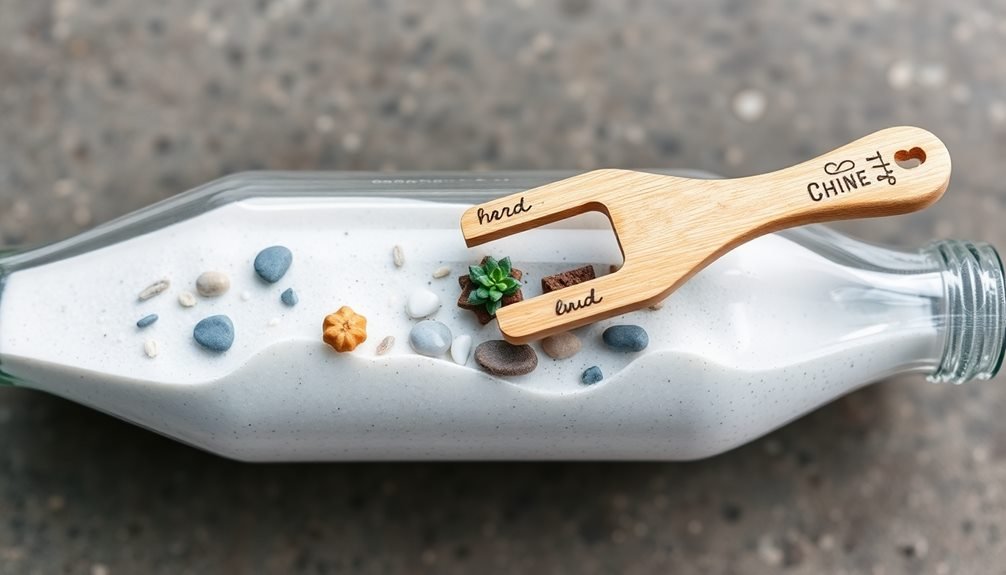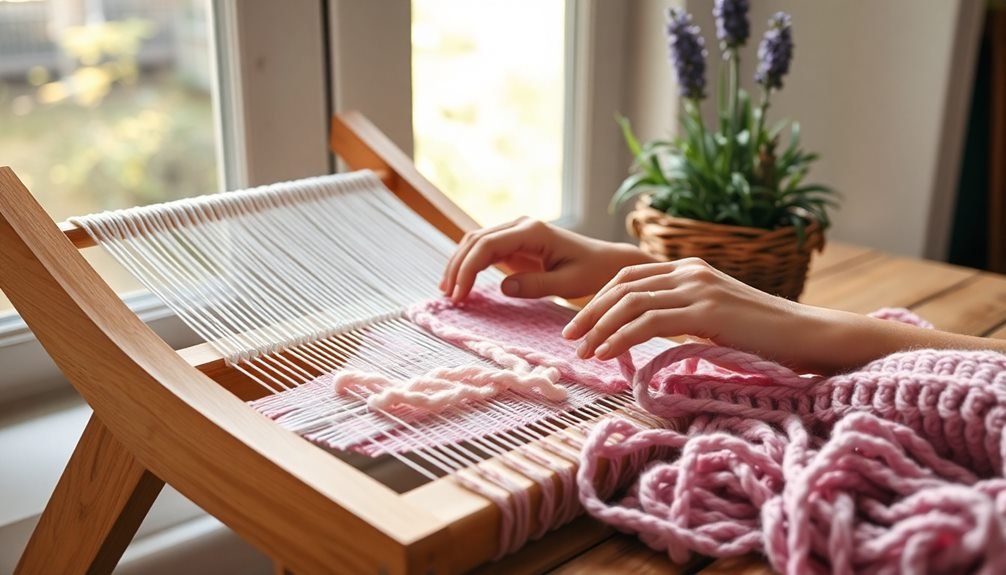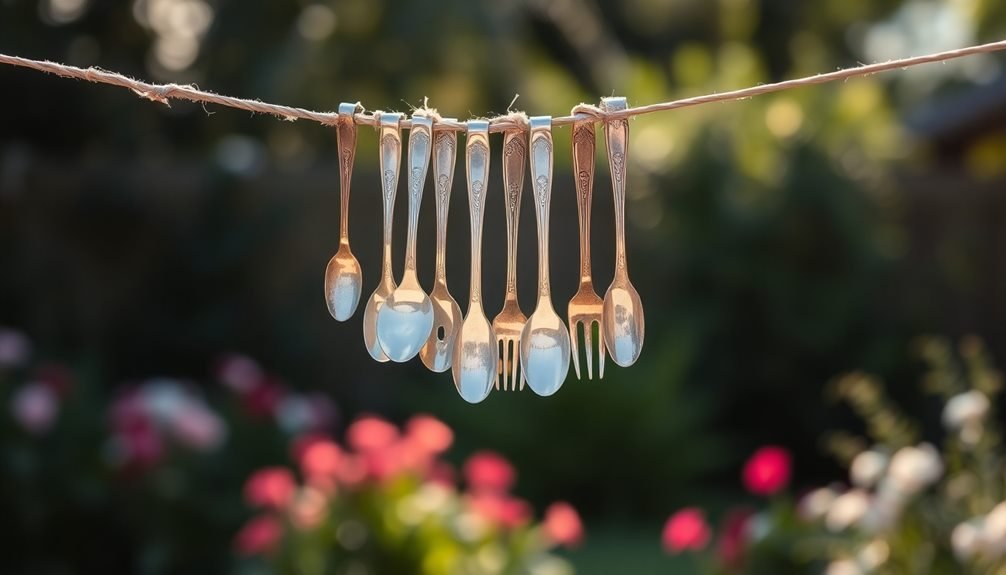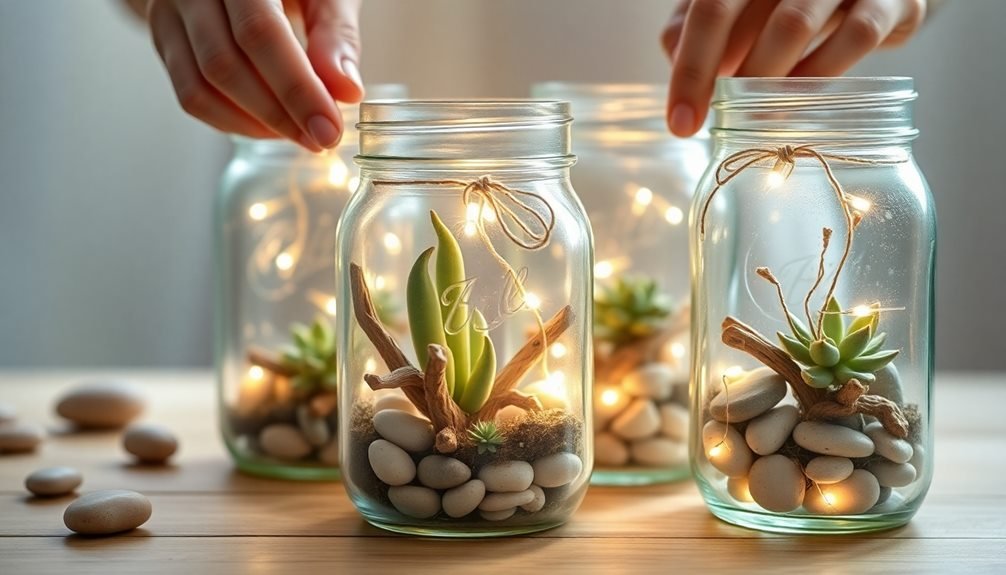Transform everyday items into calming crafts with these anxiety-relieving upcycling projects. You'll find peace in creating zen gardens from glass bottles, rolling colorful paper beads for jewelry, or weaving old t-shirts into textured wall hangings. Turn reclaimed wood into mindful painting canvases, craft memory boxes from discarded containers, and design therapeutic mason jar lanterns for gentle lighting. You can even make melodious wind chimes from vintage silverware. These hands-on activities combine sustainability with meditation, offering you both creative satisfaction and emotional balance. Each project opens the door to a more mindful approach to crafting.
Turn Bottles Into Zen Gardens

Ever wondered what to do with those empty wine or glass bottles collecting dust? Transform them into miniature zen gardens that can help calm your mind and reduce anxiety. By repurposing these bottles, you'll create a mindful activity space while giving new life to recyclable items.
Start by thoroughly cleaning and drying your chosen bottle. Using a glass cutter, carefully remove the top portion to create an open container. Sand the edges until smooth to prevent injuries.
Fill the bottom third with fine white sand or crushed quartz, then add small rocks, pebbles, or sea glass in pleasing patterns. Create depth by incorporating tiny succulents, air plants, or preserved moss.
Add miniature meditation tools like a small rake or wooden stick to draw patterns in the sand. You can even wrap twine or decorative rope around the bottle's neck for an earthy touch.
Place your bottle zen garden on your desk or nightstand. When stress builds up, take a moment to mindfully arrange the elements or draw new patterns in the sand.
This simple practice combines creative expression with meditation, offering a peaceful escape during hectic moments.
Mindful Paper Bead Making
Start your paper bead-making journey by gathering colorful magazines, wrapping paper, and other recyclable paper materials from around your home.
You'll learn to master simple rolling techniques using basic tools like toothpicks or skewers, transforming strips of paper into unique beads of various shapes and sizes.
Once you've created a collection of handmade beads, you can string them together into beautiful necklaces, bracelets, or other jewelry pieces that serve as tangible reminders of your mindful crafting sessions.
Gather Recycled Paper Materials
Through mindful collection of paper materials, you'll build the foundation for creating beautiful paper beads while practicing intentional awareness.
Begin by gathering colorful magazines, junk mail, old gift wrapping paper, and decorative tissue paper you'd normally discard. Sort these materials into piles based on colors, patterns, and textures that resonate with your current mood or aesthetic preferences.
Pay special attention to pages featuring gradients, geometric designs, or vibrant photographs that'll create interesting effects on your finished beads. Look for paper with a medium weight – too thin and it'll tear easily, too thick and it won't roll properly. Remove any staples, adhesive labels, or glossy coatings that might interfere with the beading process.
As you collect materials, focus on the tactile sensations of different paper types and notice how each texture feels between your fingers.
Store your selected papers in a dedicated folder or box, organizing them by color families or patterns. Keep an eye out for unique specialty papers like maps, sheet music, or old calendar pages that can add meaningful elements to your bead collection.
Rolling Techniques and Tips
With your collected paper materials at hand, mastering the art of rolling beads becomes a calming, meditative practice. You'll find that different rolling techniques create unique bead shapes and textures, each offering its own therapeutic benefits while you work.
Start by cutting your paper into long triangles, with the base width determining your bead size. Apply a thin layer of glue along the wider end, then place your rolling tool at the base and roll upward with steady, gentle pressure. Keep your fingers relaxed and breathe slowly as you work.
| Technique | Benefits | Best For |
|---|---|---|
| Tight Roll | Uniform shape | Jewelry making |
| Loose Roll | Organic look | Art projects |
| Tapered Roll | Professional finish | Mixed media |
As you roll, maintain consistent tension without gripping too tightly. If you're feeling anxious, focus on the paper's texture and the rhythmic motion of rolling. Once you've reached the tip, secure the end with a dot of glue and hold for 10 seconds. You'll know you've achieved the right technique when your beads are firm but not compressed, with smooth edges and even spacing.
String Beautiful Bead Necklaces
Once your handcrafted paper beads have dried completely, stringing them into a necklace becomes a mindful journey of personal expression.
You'll find that arranging these unique pieces brings a sense of calm as you focus on creating patterns and exploring different combinations. Select your stringing material carefully – waxed cotton cord, elastic thread, or jewelry wire each offers distinct advantages for your design.
When you're ready to begin stringing, follow these steps for the best results:
- Lay out your beads in your desired pattern before stringing, taking time to experiment with color flows and size variations.
- Thread your chosen cord through a needle if you're using one, leaving enough length for tying off.
- String beads from the center outward, maintaining symmetry and checking the drape as you progress.
- Secure the ends with proper jewelry findings, using crimp beads for wire or strong knots for cord.
As you work, let your mind settle into the rhythmic motion of stringing.
You'll notice how each bead placement decision helps quiet racing thoughts, making this final stage as therapeutic as the bead-rolling process itself.
Calming Textile Weaving Projects

Transform your worn-out textiles into meditative craft projects that can help calm your mind while creating something beautiful.
You'll find peace in cutting old t-shirts into strips for simple weaving projects, or turning leftover sock yarn into vibrant wall hangings that brighten your space.
Even tired sweaters can take on new life as cozy throw pillows, giving you both a therapeutic crafting experience and a practical home accent.
Simple T-Shirt Strip Weaving
Old t-shirts find new life as calming textile art through the meditative practice of strip weaving.
You'll discover that cutting and weaving strips from worn-out shirts creates a rhythmic, anxiety-reducing activity that produces beautiful, functional pieces. The repetitive motion of weaving helps quiet your mind while transforming clothing destined for the landfill into something meaningful.
To begin your weaving journey, you'll need:
- Four to six old t-shirts in complementary colors
- Sharp fabric scissors for clean, even cuts
- A simple cardboard loom (12×16 inches works well)
- Basic straight pins or tape to secure your work
Start by cutting your shirts into 1-inch strips, removing any seams or printed areas. As you work, focus on making each cut smooth and deliberate.
Create your loom by cutting notches one inch apart along the top and bottom of your cardboard. You'll weave your strips through vertical lengths of t-shirt material, called the warp, moving the horizontal pieces (weft) over and under in a steady pattern.
This gentle, flowing motion creates a therapeutic rhythm that helps release tension while producing a unique textile piece.
Sock Yarn Wall Hangings
Building on the gentle art of weaving, unraveled sock yarn offers another soothing way to create wall art while managing anxiety. You'll find that working with reclaimed yarn from old socks provides a meditative experience while giving new life to worn-out items.
Start by carefully unraveling clean, worn-out socks, rolling the yarn into balls as you go. You can create a simple frame using four wooden dowels arranged in a rectangle, or use an old picture frame with nails spaced evenly along the top and bottom. String your base yarns vertically to create the warp.
Begin weaving horizontally with your sock yarn, alternating over and under the warp threads. The repetitive motion of weaving helps quiet racing thoughts and reduces stress. Mix different colored yarns to create patterns, or stick to similar shades for a monochromatic look. You don't need to follow strict rules – let your intuition guide your design choices.
Add texture by incorporating basic weaving techniques like soumak knots or rya knots. These dimensional elements create visual interest while providing tactile satisfaction.
When you're finished, secure the edges and hang your piece using natural twine or a wooden rod.
Old Sweater Throw Pillows
Cozy sweaters past their prime become soothing throw pillows in this anxiety-reducing upcycling project.
You'll find the repetitive motions of cutting, stitching, and stuffing create a meditative experience while transforming worn-out knits into soft, tactile home decor. The familiar texture of your favorite old sweaters adds an extra layer of comfort to your relaxation space.
Start by selecting sweaters with minimal damage and washing them on gentle cycle. You'll need basic sewing supplies, pillow forms, and scissors for this calming craft. The process of working with soft materials can help ground you when anxiety strikes.
- Cut your sweater into two equal squares or rectangles, adding an extra inch for seam allowance.
- Pin the pieces together inside out, leaving one side open for stuffing.
- Sew three sides using a straight stitch, then turn right side out.
- Insert your pillow form and hand-stitch the final side closed.
Focus on the texture beneath your fingers and the steady rhythm of your stitches.
You'll find that ribbed cuffs and cable-knit patterns create interesting visual elements on your finished pillows, while the familiar fabric offers comfort during anxious moments.
Paint Meditation With Reclaimed Wood
Mindful painting on reclaimed wood pieces transforms discarded lumber into therapeutic art canvases. You'll find that weathered boards, old fence posts, and retired furniture parts offer unique textures that enhance your artistic expression while calming your mind.
Start by sanding your wood piece gently, keeping the natural imperfections that make it special. Choose calming colors that speak to you, and let your brush flow freely across the surface. Don't worry about perfection – this process is about releasing anxiety through mindful creation.
| Wood Type | Best Paint Type | Therapeutic Benefits |
|---|---|---|
| Pine | Acrylic | Stress reduction |
| Oak | Chalk | Improved focus |
| Cedar | Watercolor | Emotional release |
| Barnwood | Oil | Mindfulness practice |
| Pallet wood | Mixed media | Anxiety relief |
As you paint, focus on your breathing and the way the colors blend and flow. Let each stroke become a meditation, allowing your worries to dissolve into the artwork. You'll create not just a beautiful piece for your home, but also a tangible reminder of your journey toward inner peace through creative reuse.
Memory Box From Old Containers

While painted wood art helps release anxiety through color, transforming old containers into memory boxes offers a different kind of emotional healing.
You'll find that creating a personalized space for cherished mementos can help process emotions and celebrate joyful memories. Old cookie tins, wooden cigar boxes, or sturdy cardboard containers can become vessels for your journey toward mindfulness.
- Start by thoroughly cleaning your chosen container and removing any old labels.
- Sand rough edges if you're working with wood or metal, making the surface safe to handle during moments of anxiety.
- Cover the exterior with calming materials like soft fabric, textured paper, or pressed flowers.
- You'll want to choose elements that feel soothing to touch when you're feeling overwhelmed.
- Line the interior with plush fabric or cork, creating compartments using recycled cardboard dividers.
- This organization system helps manage both your treasures and your thoughts.
- Fill your box with meaningful items: photographs, letters, small tokens, or written affirmations.
- Each time anxiety strikes, you can open your memory box and ground yourself through these tangible connections to positive moments.
Therapeutic Mason Jar Lanterns
Through the gentle glow of repurposed mason jars, you'll discover a calming craft that combines light therapy with creative expression.
These lanterns serve as both decorative pieces and anxiety-reducing tools, offering a focused activity that helps quiet racing thoughts.
Start by collecting used mason jars and cleaning them thoroughly. You'll need battery-operated tea lights, glass paint or frost spray, decorative elements like twine or lace, and your choice of embellishments.
As you work, focus on your breathing and let the repetitive motions of decorating ground you in the present moment.
Create patterns by applying frost spray in layers, or use glass paint to make intricate designs. You can wrap twine around the jar's neck, adding texture and visual interest.
For extra therapeutic value, choose colors known for their calming properties – soft blues, gentle greens, or warming ambers.
Place your finished lanterns where you'll see them during anxiety-prone moments. The soft illumination creates a soothing atmosphere, while the pride in your handcrafted piece reinforces positive emotions.
You can also arrange multiple lanterns to create a dedicated relaxation corner in your home.
Soothing Wind Chimes From Silverware

Creating wind chimes from vintage silverware transforms ordinary utensils into musical instruments that can ease anxiety with their gentle tinkling.
You'll discover that different sizes and shapes of spoons, forks, and butter knives produce unique tones when they strike each other in the breeze. This meditative project lets you focus on the present moment while crafting something beautiful and functional.
To create your silverware wind chimes, you'll need to follow these essential steps:
- Select 6-8 pieces of silverware with varying lengths and weights to create diverse sounds, focusing on pieces that produce clear, pleasant tones when tapped together.
- Drill small holes near the top of each utensil handle, using a metal drill bit and working slowly to prevent splitting.
- Thread strong fishing line or thin wire through the holes, securing each piece at different lengths from your chosen base (like a wooden circle or metal ring).
- Hang a central striker piece that will connect with the surrounding silverware when the wind blows.
As you work with the materials, let the repetitive actions of measuring, drilling, and knotting become a mindful exercise that grounds you in the moment.
Frequently Asked Questions
How Do I Safely Clean Materials Found in Nature for Upcycling Projects?
You'll want to gently brush off debris, soak items in warm water with mild soap, disinfect with diluted bleach solution, and thoroughly dry everything. For wood, lightly sand and treat with mineral oil.
Can Upcycling Activities Be Incorporated Into Group Therapy Sessions?
You'll find upcycling works great in group therapy settings. Let your participants collaborate on projects, share creative ideas, and build social connections while transforming materials. It's an engaging way to foster therapeutic discussions.
What Are the Best Anxiety-Tracking Methods While Doing Upcycling Projects?
You'll get the best anxiety tracking results by keeping a mood journal, using anxiety rating scales (0-10), noting physical symptoms, and timing how long you feel calm while working on your projects.
Which Upcycling Projects Are Most Suitable for Severe Anxiety Episodes?
When you're experiencing severe anxiety, try small fabric projects like making pillowcases or simple quilting. You'll find comfort in repetitive stitching, and you won't feel overwhelmed by complex tasks or timelines.
How Long Should Each Upcycling Session Last for Maximum Therapeutic Benefit?
You'll want to work in 20-30 minute sessions when you're feeling anxious. If you're comfortable, extend it to an hour, but don't push yourself. Take breaks whenever you need to reset.
In Summary
You've now got seven meaningful ways to transform everyday discards into tools for tranquility. Whether you're creating a miniature zen garden or weaving old t-shirts into something new, each project offers a mindful escape from daily stress. Don't let anxiety hold you back – start small with any of these projects and watch how the creative process naturally soothes your mind while giving new life to forgotten items.





Leave a Reply